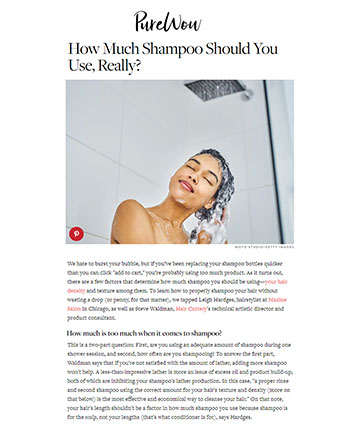Pure Wow October 15, 2021
 PureWow
PureWow
Beauty
How Much Shampoo Should You Use, Really?
We hate to burst your bubble, but if you’ve been replacing your shampoo bottles quicker than you can click "add to cart," you’re probably using too much product. As it turns out, there are a few factors that determine how much shampoo you should be using—your hair density and texture among them. To learn how to properly shampoo your hair without wasting a drop (or penny, for that matter), we tapped Leigh Hardges, hairstylist at Maxine Salon in Chicago, as well as Steve Waldman, Hair Cuttery's technical artistic director and product consultant.
How much is too much when it comes to shampoo?
This is a two-part question: First, are you using an adequate amount of shampoo during one shower session, and second, how often are you shampooing? To answer the first part, Waldman says that if you're not satisfied with the amount of lather, adding more shampoo won't help. A less-than-impressive lather is more an issue of excess oil and product build-up, both of which are inhibiting your shampoo's lather production. In this case, "a proper rinse and second shampoo using the correct amount for your hair's texture and density (more on that below) is the most effective and economical way to cleanse your hair." On that note, your hair's length shouldn't be a factor in how much shampoo you use because shampoo is for the scalp, not your lengths (that's what conditioner is for), says Hardges.
Frequency-wise, Waldman says that it's important to ask yourself if a wash is what your hair really needs at the time. "Do you really need shampoo? Or will a thorough rinse and condition give you the refresh you need? Over-cleansing can remove your hair's natural oils, which are essential for both hair and scalp health," he notes. "Also, hair doesn't hold style when it's squeaky clean. Squeaky-clean strands have been stripped of the oils it needs for health, shine, and manageability," he says.
Bottom line: Don't use shampoo when just a rinse will do. “When in doubt, thoroughly rinse your hair with plain water, shake out the excess, and see how it feels,” says Waldman. If it doesn’t feel oily, save the shampoo for your next shower session.
OK, so how much shampoo should I *actually* be using?
"The two most important factors in determining the correct amount of shampoo are your hair's texture and density," explains Waldman. As a rule of thumb, fine hair requires about a nickel-sized amount of shampoo, while those with thicker textures should use roughly two quarters worth of shampoo. If your hair is somewhere in the middle, a quarter-sized amount is adequate. Also, the curlier your hair is, the more you may need to up the amount of shampoo used.
Is a drugstore shampoo as effective as a fancier formula?
According to Waldman, the easiest way to make shampoo more affordable is to add an excess amount of water to the formula. That's why oftentimes, the more affordable shampoos claim to "use the same ingredients as professional shampoos—which may be true—but the ingredients are in such small amounts (and mixed with other less effective ingredients) that more of it is needed to reap the full benefits," he explains. "Professional products, on the other hand, usually contain less water and fillers, and their formula contains the active ingredients needed in an amount designed for optimization."
"The active ingredients of a professional shampoo make up a larger percentage of the formula, as compared to the same ingredient used in more affordable shampoos," says Hardges. While more expensive up front, higher-quality shampoos may save you money in the long run.
Break it down for me: What's the correct way to shampoo my hair so I don't waste a drop?
1. Pre-rinse your hair. This means running it under water for a minute or two, so it’s fully soaked before even reaching for your shampoo. "Pre-rinsing is a great way to remove any surface debris and build-up that may interfere with your shampoo. It can also even out the porosity of your hair, allowing the shampoo to coat it more effortlessly," says Waldman. Curlier, collier hair types will especially benefit from doing a pre-rinse, as will those who only shampoo once a week. “This is because there's more oil on the scalp, which can make building a lather with your shampoo more challenging, says Hardges.
2. Avoid pouring shampoo right out of the bottle directly on top of your head. Not only will you use more product than necessary this way, but it can also weigh down your hair and rob you of volume. Instead, emulsify the correct amount into your hands, then apply it to the scalp and massage.
3. Start at the nape of the neck. "This is where hair is usually the thickest and most abundant. Gradually work your way toward the front of your hairline. Hair at the top and front requires less shampoo since it's usually not as thick or dense," says Waldman. Massage it into your scalp for two minutes (this also increases circulation, which can boost hair growth and yield shinier hair, says Hardges) and rinse until the water runs clear.
Do I need to double-shampoo my hair?
"If your hair is thick and coarse, curly or coily, or you use a lot of styling products regularly, shampooing twice with a thorough rinse in between will ensure your hair is clean," notes Waldman.
When double-shampooing, Hardges recommends using a clarifying shampoo first to get rid of any product, dirt, and oil buildup on the scalp. Then, rinse and use a second shampoo that addresses your specific hair need—whether it’s encouraging your natural curl shape or adding volume to fine hair.
